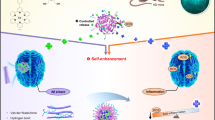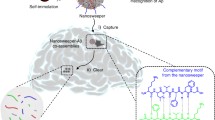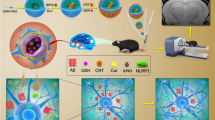Abstract
The aggregation of amyloid-β peptide (Aβ) is implicated in the pathology of Alzheimer’s disease (AD), and Aβ oligomers are considered the most toxic species. Therefore, the detection and clearance of Aβ oligomers are crucial for the theranostic strategies for AD. However, effective methods for the detection of Aβ oligomers are rare, and only few of the oligomer-specific sensors have therapeutic functions as well. Recent studies have demonstrated that the toxicity of Aβ oligomers is related to the number of exposed hydrophobic residues. In this study, an oligomer-specific fluorescent probe, which was based on the hydrophobic regions that are exposed on Aβ oligomer surfaces was designed and synthesized. For improving the ability to recognize Aβ oligomers, the in situ treatment of AD symptoms and the ability to penetrate the blood-brain barrier, the probe and KLVFF peptide (an Aβ-target peptide) were modified on the surfaces of magnetic nanoparticles (MNP@NFP-pep). This complex could detect Aβ oligomers specifically, and achieve the wireless deep magnetothermally mediated disaggregation of Aβ aggregates with an alternating magnetic field. This work provides new insights into the development of a “sense and treat” system for AD therapy.

Similar content being viewed by others
References
Blennow, K.; de Leon, M. J.; Zetterberg, H. Alzheimer’s disease. Lancet 2006, 368, 387–403.
Rijal Upadhaya, A.; Kosterin, I.; Kumar, S.; von Arnim, C. A. F.; Yamaguchi, H.; Fä ndrich, M.; Walter, J.; Thal, D. R. Biochemical stages of amyloid-ß peptide aggregation and accumulation in the human brain and their association with symptomatic and pathologically preclinical Alzheimer’s disease. Brain 2014, 137, 887–903.
Koffie, R. M.; Meyer-Luehmann, M.; Hashimoto, T.; Adams, K. W.; Mielke, M. L.; Garcia-Alloza, M.; Micheva, K. D.; Smith, S. J.; Kim, M. L.; Lee, V. M. et al. Oligomeric amyloid ß associates with postsynaptic densities and correlates with excitatory synapse loss near senile plaques. Proc. Nat. Acad. Sci. USA 2009, 106, 4012–4017.
Li, S. M.; Hong, S.; Shepardson, N. E.; Walsh, D. M.; Shankar, G. M.; Selkoe, D. Soluble oligomers of amyloid ß protein facilitate hippocampal long-term depression by disrupting neuronal glutamate uptake. Neuron 2009, 62, 788–801.
Haaßs, C.; Selkoe, D. J. Soluble protein oligomers in neurodegeneration: Lessons from the Alzheimer’s amyloid ß-peptide. Nat. Rev. Mol. Cell. Biol. 2007, 8, 101–112.
Krishnan, R.; Goodman, J. L.; Mukhopadhyay, S.; Pacheco, C. D.; Lemke, E. A.; Deniz, A. A.; Lindquist, S. Conserved features of intermediates in amyloid assembly determine their benign or toxic states. Proc. Nat. Acad. Sci. USA 2012, 109, 11172–11177.
Ladiwala, A. R.; Litt, J.; Kane, R. S.; Aucoin, D. S.; Smith, S. O.; Ranjan, S.; Davis, J.; Van Nostrand, W. E.; Teßsier, P. M. Conformational differences between two amyloid ß oligomers of similar size and dissimilar toxicity. J. Biol. Chem. 2012, 287, 24765–24773.
Campioni, S.; Mannini, B.; Zampagni, M.; Pensalfini, A.; Parrini, C.; Evangelisti, E.; Relini, A.; Stefani, M.; Dobson, C. M.; Cecchi, C. et al. A causative link between the structure of aberrant protein oligomers and their toxicity. Nat. Chem. Biol. 2010, 6, 140–147.
Cassagnes, L. E.; Hervé, V.; Nepveu, F.; Hureau, C.; Faller, P.; Collin, F. The catalytically active copper-amyloid-Beta state: Coordination site responsible for reactive oxygen species production. Angew. Chem., Int. Ed. 2013, 52, 11110–11113.
Hamley, I. W. The amyloid beta peptide: A chemist’s perspective. Role in Alzheimer’s and fibrillization. Chem. Rev. 2012, 112, 5147–5192.
Jakob-Roetne, R.; Jacobsen, H. Alzheimer’s disease: From pathology to therapeutic approaches. Angew. Chem., Int. Ed. 2009, 48, 3030–3059.
Morgado, I.; Wieligmann, K.; Bereza, M.; Rönicke, R.; Meinhardt, K.; Annamalai, K.; Baumann, M.; Wacker, J.; Hortschansky, P.; Maleševic, M. et al. Molecular basis of ß-amyloid oligomer recognition with a conformational antibody fragment. Proc. Natl. Acad. Sci. USA 2012, 109, 12503–12508.
Takahashi, T.; Mihara, H. FRET detection of amyloid ß-peptide oligomerization using a fluorescent protein probe presenting a pseudo-amyloid structure. Chem. Commun. 2012, 48, 1568–1570.
Bruggink, K. A.; Jongbloed, W.; Biemans, E. A. L. M.; Veerhuis, R.; Claaßsen, J. A. H. R.; Kuiperij, H. B.; Verbeek, M. M. Amyloid-ß oligomer detection by ELISA in cerebrospinal fluid and brain tissue. Anal. Biochem. 2013, 433, 112–120.
Teoh, C. L.; Su, D. D.; Sahu, S.; Yun, S. W.; Drummond, E.; Prelli, F.; Lim, S.; Cho, S.; Ham, S.; Wisniewski, T. et al. Chemical fluorescent probe for detection of aß oligomers. J. Am. Chem. Soc. 2015, 137, 13503–13509.
Lv, G. L.; Sun, A. Y.; Wei, P.; Zhang, N.; Lan, H. C.; Yi, T. A spiropyran-based fluorescent probe for the specific detection of ß-amyloid peptide oligomers in Alzheimer’s disease. Chem. Commun. 2016, 52, 8865–8868.
Chen, Q. W.; Wen, J.; Li, H. J.; Xu, Y. Q.; Liu, F. Y.; Sun, S. G. Recent advances in different modal imaging-guided photothermal therapy. Biomaterials 2016, 106, 144–166.
Li, M.; Zhao, A. D.; Dong, K.; Li, W.; Ren, J. S.; Qu, X. G. Chemically exfoliated WS2 nanosheets efficiently inhibit amyloid ß-peptide aggregation and can be used for photothermal treatment of Alzheimer’s disease. Nano Res. 2015, 8, 3216–3227.
Li, M.; Yang, X. J.; Ren, J. S.; Qu, K. G.; Qu, X. G. Using graphene oxide high near-infrared absorbance for photothermal treatment of Alzheimer’s disease. Adv. Mater. 2012, 24, 1722–1728.
Bastus, N. G.; Kogan, M. J.; Amigo, R.; Grillo-Bosch, D.; Araya, E.; Turiel, A.; Labarta, A.; Giralt, E.; Puntes, V. F. Gold nanoparticles for selective and remote heating of ß-amyloid protein aggregates. Mater. Sci. Eng. C 2007, 27, 1236–1240.
Weissleder, R. A clearer vision for in vivo imaging. Nat. Nanotechnol. 2001, 19, 316–317.
Chen, R.; Romero, G.; Christiansen, M. G.; Mohr, A.; Anikeeva, P. Wireless magnetothermal deep brain stimulation. Science 2015, 347, 1477–1480.
Colombo, M.; Carregal-Romero, S.; Casula, M. F.; Gutiérrez, L.; Morales, M. P.; Böhm, I. B.; Heverhagen, J. T.; Prosperi, D.; Parak, W. J. Biological applications of magnetic nanoparticles. Chem. Soc. Rev. 2012, 41, 4306–4334.
Riedinger, A.; Guardia, P.; Curcio, A.; Garcia, M. A.; Cingolani, R.; Manna, L.; Pellegrino, T. Subnanometer local temperature probing and remotely controlled drug release based on azo-functionalized iron oxide nanoparticles. Nano Lett. 2013, 13, 2399–2406.
Huang, H.; Delikanli, S.; Zeng, H.; Ferkey, D. M.; Pralle, A. Remote control of ion channels and neurons through magnetic-field heating of nanoparticles. Nat. Nanotechnol. 2010, 5, 602–606.
Reddy, L. H.; Arias, J. L.; Nicolas, J.; Couvreur, P. Magnetic nanoparticles: design and characterization, toxicity and biocompatibility, pharmaceutical and biomedical applications. Chem. Rev. 2012, 112, 5818–5878.
Viola, K. L.; Sbarboro, J.; Sureka, R.; De, M.; Bicca, M. A.; Wang, J.; Vasavada, S.; Satpathy, S.; Wu, S.; Joshi, H. et al. Towards non-invasive diagnostic imaging of early-stage Alzheimer’s disease. Nat. Nanotechnol. 2015, 10, 91–98.
Hu, B. B.; Dai, F. Y.; Fan, Z. M.; Ma, G. H.; Tang, Q. W.; Zhang, X. Nanotheranostics: Congo Red/Rutin-MNPs with enhanced magnetic resonance imaging and H2O2-responsive therapy of Alzheimer’s disease in APPswe/PS1dE9 transgenic mice. Adv. Mater. 2015, 27, 5499–5505.
Duke, R. M.; Veale, E. B.; Pfeffer, F. M.; Kruger, P. E.; Gunnlaugsson, T. Colorimetric and fluorescent anion sensors: An overview of recent developments in the use of 1,8-naphthalimide-based chemosensors. Chem. Soc. Rev. 2010, 39, 3936–3953.
Li, M.; Xu, C.; Wu, L.; Ren, J. S.; Wang, E. B.; Qu, X. G. Self-aßsembled peptide-polyoxometalate hybrid nanospheres: Two in one enhances targeted inhibition of amyloid ß-peptide aggregation associated with Alzheimer’s disease. Small 2013, 9, 3455–3461.
Tang, Y. H.; Kong, X. Q.; Xu, A.; Dong, B. L.; Lin, W. Y. Development of a two-photon fluorescent probe for imaging of endogenous formaldehyde in living tissues. Angew. Chem., Int. Ed. 2016, 55, 3356–3359.
Breul, A. M.; Hager, M. D.; Schubert, U. S. Fluorescent monomers as building blocks for dye labeled polymers: Synthesis and application in energy conversion, biolabeling and sensors. Chem. Soc. Rev. 2013, 42, 5366–5407.
Huang, C. S.; Yin, Q.; Zhu, W. P.; Yang, Y.; Wang, X.; Qian, X. H.; Xu, Y. F. Highly selective fluorescent probe for vicinal-dithiol-containing proteins and in situ imaging in living cells. Angew. Chem., Int. Ed. 2011, 50, 7551–7556.
Wang, J. S.; Zhao, C. Q.; Zhao, A. D.; Li, M.; Ren, J. S.; Qu, X. G. New insights in amyloid beta interactions with human telomerase. J. Am. Chem. Soc. 2015, 137, 1213–1219.
Bolognesi, B.; Kumita, J. R.; Barros, T. P.; Esbjorner, E. K.; Luheshi, L. M.; Crowther, D. C.; Wilson, M. R.; Dobson, C. M.; Favrin, G.; Yerbury, J. J. ANS binding reveals common features of cytotoxic amyloid species. ACS Chem. Biol. 2010, 5, 735–740.
Zhang, X. L.; Tian, Y. L.; Li, Z.; Tian, X. Y.; Sun, H. B.; Liu, H.; Moore, A.; Ran, C. Z. Design and synthesis of curcumin analogues for in vivo fluorescence imaging and inhibiting copper-induced cross-linking of amyloid beta species in Alzheimer’s disease. J. Am. Chem. Soc. 2013, 135, 16397–16409.
Hamley, I. W. Peptide fibrillization. Angew. Chem., Int. Ed. 2007, 46, 8128–8147.
Gao, N.; Sun, H. J.; Dong, K.; Ren, J. S.; Duan, T. C.; Xu, C.; Qu, X. G. Transition-metal-substituted polyoxometalate derivatives as functional anti-amyloid agents for Alzheimer’s disease. Nat. Commun. 2014, 5, 3422.
Li, M.; Liu, Z.; Ren, J. S.; Qu, X. G. Inhibition of metalinduced amyloid aggregation using light-responsive magnetic nanoparticle prochelator conjugates. Chem. Sci. 2012, 3, 868–873.
Gao, N.; Sun, H. J.; Dong, K.; Ren, J. S.; Qu, X. G. Goldnanoparticle-based multifunctional amyloid-beta inhibitor against Alzheimer’s disease. Chem.— Eur. J. 2015, 21, 829–835.
Geng, J.; Li, M.; Ren, J. S.; Wang, E. B.; Qu, X. G. Polyoxometalates as inhibitors of the aggregation of amyloid ß peptides associated with Alzheimer’s disease. Angew. Chem., Int. Ed. 2011, 50, 4184–4188.
Hong, Y. N.; Meng, L. M.; Chen, S. J.; Leung, C. W. T.; Da, L. T.; Faisal, M.; Silva, D. A.; Liu, J. Z.; Lam, J. W. Y.; Huang, X. H. et al. Monitoring and inhibition of insulin fibrillation by a small organic fluorogen with aggregationinduced emission characteristics. J. Am. Chem. Soc. 2012, 134, 1680–1689.
Li, C. X.; Born, A. K.; Schweizer, T.; Zenobi-Wong, M.; Cerruti, M.; Mezzenga, R. Amyloid-hydroxyapatite bone biomimetic composites. Adv. Mater. 2014, 26, 3207–3212.
Bruce, I. J.; Sen, T. Surface modification of magnetic nanoparticles with alkoxysilanes and their application in magnetic bioseparations. Langmuir 2005, 21, 7029–7035.
Guan, Y. J.; Li, M.; Dong, K.; Gao, N.; Ren, J. S.; Zheng, Y. C.; Qu, X. G. Ceria/POMs hybrid nanoparticles as a mimicking metallopeptidase for treatment of neurotoxicity of amyloid-ß peptide. Biomaterials 2016, 98, 92–102.
Acknowledgements
Financial support was provided by the National Basic Research Program of China (973 Program) (No. 2012CB720602), the Project of Science and Technology Development Plan for Jilin Province (No. 20150520004JH) and the National Natural Science Foundation of China (NSFC) (Nos. 21210002, 21431007, 21402183 and 21533008).
Author information
Authors and Affiliations
Corresponding authors
Electronic supplementary material
Rights and permissions
About this article
Cite this article
Du, Z., Gao, N., Guan, Y. et al. Rational design of a “sense and treat” system to target amyloid aggregates related to Alzheimer’s disease. Nano Res. 11, 1987–1997 (2018). https://doi.org/10.1007/s12274-017-1815-9
Received:
Revised:
Accepted:
Published:
Issue Date:
DOI: https://doi.org/10.1007/s12274-017-1815-9




